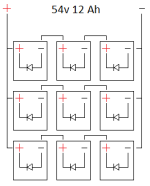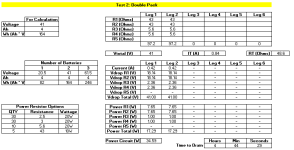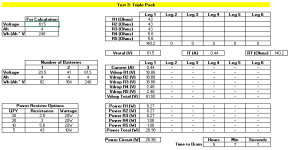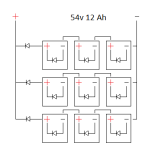Hello,
I’m working on converting my 49cc Pocket Bike to Electric but want to ensure that I do it safely and am hoping for some help. The key area that I need help finalizing is the power source which I want to use Ridgid 18V 4Ah batteries (x9). The rational for this is that I have lots of these laying around already and therefore do not need to purchase any additional batteries – plus, when not in use for the bike they will be in use for my power tools.
Motor:
Vevor kit
Model: MY1020D
Input Voltage: 48v
Rated Current: 33A
Input Power: 1800 watts (at 54 Volts and 33 Amps)
Rated Speed: 4500 rpm
Max Speed: 5200 rpm
Controller Specs:
Model: BY15WF01-A
Current: 33A
Phase Degree: 120°
Conversion Efficiency: 90%
Low Voltage Protection Shutoff: 41±0.5V
Batteries:
Would like to use 9x Ridgid 18v 4aH batteries 3S3P configuration for a total of 54v 12Ah (648wH) which equates to about 22 minutes at full rated power. I am also considering only running 6 batteries which would give me 54v 8Ah (432wH) which equates to about 14 minutes. I doubt I’ll be at full power for more than a few seconds ever. So I imagine 6 would be more than enough but have no problem fitting the full 9. Another reason to use these is I know they are high quality lithium cells compared to buying a battery pack off Amazon or Ebay. The 4Ah Ridgid batteries contain either Samsung 20R, Eve 20P or Lishen LR1865LA cells in 5s2p configurations. So the total current of each pack varies from 40-60 amps, less than the output required.
My questions here pertain to safety as I’m not expecting tons of range on this thing nor do I need it. It will be used in parking lots only when I’m at racetracks. So I’m never a far walk from the car.
Wire Sizing Note: I’ll be using a 35A fuse (Max 40A) and 8AWG wire on the positive terminal line to limit overall circuit amperage to the controller. I’ll run 12 gauge wire on each of the series runs with a 20A fuse on each of those legs. Expecting 11A per leg (33A rated/3 parallel legs).
General Comment on 54v: Fully charged batteries will be approx. 20.5v so about 61.5v. I’ve heard that some of the caps inside the controller might be 63v caps. That being said, I’ve seen lots of videos of people using larger capacity batteries with that controller with no issues. Vevor also states that the motor can run on 45-54v batteries. Also batteries will always be at the same state of charge when starting out.
Safety Question 1: Diodes and BMS
The specific packs that I plan on using are Ridgid which have BMS systems completely within the battery pack. From research they provide the low voltage protection so I don’t need to worry about incorporating that. What I have found online is mention of protecting the BMS from other packs when one shuts off. Sounds like a Schottkey Diode is needed for each pack. The one suggested online is discontinued now. onsemi 600V 50A, Rectifier Diode, 2-Pin TO-247 RHRG5060. I’ve found another one that I believe is sufficient
ST40250 (250v, 40A)
https://www.digikey.ca/en/products/detail/smc-diode-solutions/ST40250/21705610
Any thoughts or comments on this? Did I spec the diode correctly? I went for a cheap option which has an amperage and voltage sufficient to the application. Also…what does the diode do exactly in this case?
Safety Question 2: BMS shutdown….now what.
So….when a BMS is activated…it sounds like voltage continues to flow but just not threw that pack? Or does it completely disable that Parallel chain? If it still allows the other two packs in that chain to provide power then I would have 2 sets with 54v and the remaining leg would only be providing 36v. What happens in this case?
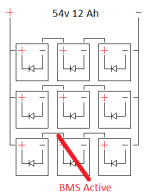
Non Safety Question…
Any recommendations on Sprocket Sizing? The rear tire diameter is only 10.8inches. Stock setup was a 6T front sprocket and a 68T rear. But that is an 11.33:1 ratio which shows a top speed of 12.8 MPH. From what I’ve seen online it appears that I should gear it for roughly 33.04 mph top speed. I don’t want to overload motor and will use throttle to ensure I keep my speed in check.
Final Comment:
Please point out safety concerns with this setup (other than a pocket bike with a 2.5hp motor)! I want to ensure that this is safe in terms of the batteries. Lithium Battery’s on fire really suck… with the BMS I don’t imagine I’ll have that much of an issue but I also don’t want to blow my battery packs.
Thanks!
I’m working on converting my 49cc Pocket Bike to Electric but want to ensure that I do it safely and am hoping for some help. The key area that I need help finalizing is the power source which I want to use Ridgid 18V 4Ah batteries (x9). The rational for this is that I have lots of these laying around already and therefore do not need to purchase any additional batteries – plus, when not in use for the bike they will be in use for my power tools.
Motor:
Vevor kit
Model: MY1020D
Input Voltage: 48v
Rated Current: 33A
Input Power: 1800 watts (at 54 Volts and 33 Amps)
Rated Speed: 4500 rpm
Max Speed: 5200 rpm
Controller Specs:
Model: BY15WF01-A
Current: 33A
Phase Degree: 120°
Conversion Efficiency: 90%
Low Voltage Protection Shutoff: 41±0.5V
Batteries:
Would like to use 9x Ridgid 18v 4aH batteries 3S3P configuration for a total of 54v 12Ah (648wH) which equates to about 22 minutes at full rated power. I am also considering only running 6 batteries which would give me 54v 8Ah (432wH) which equates to about 14 minutes. I doubt I’ll be at full power for more than a few seconds ever. So I imagine 6 would be more than enough but have no problem fitting the full 9. Another reason to use these is I know they are high quality lithium cells compared to buying a battery pack off Amazon or Ebay. The 4Ah Ridgid batteries contain either Samsung 20R, Eve 20P or Lishen LR1865LA cells in 5s2p configurations. So the total current of each pack varies from 40-60 amps, less than the output required.
My questions here pertain to safety as I’m not expecting tons of range on this thing nor do I need it. It will be used in parking lots only when I’m at racetracks. So I’m never a far walk from the car.
Wire Sizing Note: I’ll be using a 35A fuse (Max 40A) and 8AWG wire on the positive terminal line to limit overall circuit amperage to the controller. I’ll run 12 gauge wire on each of the series runs with a 20A fuse on each of those legs. Expecting 11A per leg (33A rated/3 parallel legs).
General Comment on 54v: Fully charged batteries will be approx. 20.5v so about 61.5v. I’ve heard that some of the caps inside the controller might be 63v caps. That being said, I’ve seen lots of videos of people using larger capacity batteries with that controller with no issues. Vevor also states that the motor can run on 45-54v batteries. Also batteries will always be at the same state of charge when starting out.
Safety Question 1: Diodes and BMS
The specific packs that I plan on using are Ridgid which have BMS systems completely within the battery pack. From research they provide the low voltage protection so I don’t need to worry about incorporating that. What I have found online is mention of protecting the BMS from other packs when one shuts off. Sounds like a Schottkey Diode is needed for each pack. The one suggested online is discontinued now. onsemi 600V 50A, Rectifier Diode, 2-Pin TO-247 RHRG5060. I’ve found another one that I believe is sufficient
ST40250 (250v, 40A)
https://www.digikey.ca/en/products/detail/smc-diode-solutions/ST40250/21705610
Any thoughts or comments on this? Did I spec the diode correctly? I went for a cheap option which has an amperage and voltage sufficient to the application. Also…what does the diode do exactly in this case?
Safety Question 2: BMS shutdown….now what.
So….when a BMS is activated…it sounds like voltage continues to flow but just not threw that pack? Or does it completely disable that Parallel chain? If it still allows the other two packs in that chain to provide power then I would have 2 sets with 54v and the remaining leg would only be providing 36v. What happens in this case?

Non Safety Question…
Any recommendations on Sprocket Sizing? The rear tire diameter is only 10.8inches. Stock setup was a 6T front sprocket and a 68T rear. But that is an 11.33:1 ratio which shows a top speed of 12.8 MPH. From what I’ve seen online it appears that I should gear it for roughly 33.04 mph top speed. I don’t want to overload motor and will use throttle to ensure I keep my speed in check.
Final Comment:
Please point out safety concerns with this setup (other than a pocket bike with a 2.5hp motor)! I want to ensure that this is safe in terms of the batteries. Lithium Battery’s on fire really suck… with the BMS I don’t imagine I’ll have that much of an issue but I also don’t want to blow my battery packs.
Thanks!
Attachments
Last edited:


